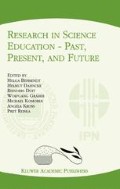Abstract
Recent literature clearly shows that girls in middle and high schools are not very interested in physics classes. There are a number of proposals now detailing what physics classes should be like in order to take gender issues into consideration (Hoffmann, Häußler, & Peters-Haft, 1997). These suggestions are basically drawn from results of questionnaires investigating the interests and attitudes of boys and girls. Some studies seem to indicate that particularly constructivist approaches lead to a higher acceptance among girls (Stadler, 1998). However, boys and girls are not only different with regard to their interests but also concerning their social behaviour, their working methods and their language (Gilligan, 1982). On the basis of these results, the findings of a study on students’ attempts to make sense of a pendulum showing chaotic behaviour (Stadler & Duit, 1997) led us to the hypothesis that boys and girls come to physics classes with different notions of understanding and hence differ in their social and linguistic behaviour.
Access this chapter
Tax calculation will be finalised at checkout
Purchases are for personal use only
Preview
Unable to display preview. Download preview PDF.
References
Duit, R., Komorek, M., Wilbers, J., Roth, W.M. & Stadler, H. (1997). Eine Unterrichtseinheit zur eingeschränkten Vorhersagbarkeit chaotischer Systeme für das 10. Schuljahr [A teaching unit on limited predictability of chaotic systems]. In J. Willer, Ed., Didaktik der Physik. Vorträge Frühjahrstagung Berlin (pp. 276–281). Bad Honneff, Germany: Deutsche Physikalische Gesellschaft.
Gilligan, C. (1982). In a different voice. Psychological theory and women’s development. Cambridge, MA: Harvard University Press.
Hatch, E. (1992). Discourse and language education. Cambridge, MA: Cambridge University Press.
Hoffmann, L, Häußler, P., & Peters-Haft, S. (1997). An den Interessen von Jungen und Mädchen orientierter Physikunterricht [Physics instruction oriented towards boys’ and girls’ interests]. Kiel, Germany: IPN-Institute for Science Education.
Keil, F. C. (1992). The origins of an autonomous biology. In G. R. Megan & M. Maratsos, Eds., Modularity and constraints in language and cognition. The Minnesota Symposia on Child Psychology, Vol. 25 (pp. 103–137). Hillsdale, NJ: Erlbaum.
Lier, L. van (1988). The classroom and the language learner. London: Longman.
Resnick, L. B., Salmon, M., Zeitz, C. M., Wathen, S. H., & Holowchak, M. (1993). Reasoning in conversation. Cognition and Instruction 11, 347–364.
Stadler, H. & Duit, R. (1997, September). Teaching and learning chaos theory-Case studies on students’ learning pathways. Paper presented within the Poster Symposium “Studies on Educational Reconstruction of Chaos Theory” at the ESERA Conference in Rome.
Stadler, H. (1998). Die Bewegung der Erde. Ein Einführungsunterricht in die Mechanik [The movement of the earth-an introduction into mechanics]. Unterricht Physik 9,46, 24–34.
Tannen, D. (1994). Gender and discourse. New York, Oxford: Oxford University Press.
Wagenschein, M. (1976). Die pädagogische Dimension der Physik [The pedagogical dimension of physics]. Braunschweig, Germany: Georg Westermann Verlag.
Zohar, A. & Ginossar, S. (1998). Lifting the Taboo regarding teleology and anthropomorphism in biology education-heretical suggestions. Science Education 82, 679–697.
Author information
Authors and Affiliations
Editor information
Editors and Affiliations
Rights and permissions
Copyright information
© 2001 Kluwer Academic Publishers
About this chapter
Cite this chapter
Stadler, H., Benke, G., Duit, R. (2001). How do Boys and Girls use Language in Physics Classes?. In: Behrendt, H., et al. Research in Science Education - Past, Present, and Future. Springer, Dordrecht. https://doi.org/10.1007/0-306-47639-8_39
Download citation
DOI: https://doi.org/10.1007/0-306-47639-8_39
Publisher Name: Springer, Dordrecht
Print ISBN: 978-0-7923-6755-0
Online ISBN: 978-0-306-47639-6
eBook Packages: Springer Book Archive

